KENSINGTON PALACE: HISTORY AND PERSONALITIES, PART I
July 17th 2013
We are in the midst of a delicious high summer. Andy Murray has won the tennis and the strawberries and cream have been eaten and forgotten. Masterpiece London 2013 where Raffety Clocks successfully exhibited has now closed its doors until next season. Royal Ascot saw Her Majesty the Queen win the Gold Cup when her filly, Estimate won the race. It was the first time in the race’s 206 year history that a reigning Monarch had been honoured with such an exciting accolade and this being the 60th anniversary of the Coronation too. No wonder London is basking in glorious sunshine!
To top all of these amazing events there is further excitement and anticipation a foot as in the next few days Britain, and indeed, the world, are looking forward to hearing good news from the two young, vibrant and glamorous of couples, TRH The Duke and Duchess of Cambridge as they are expecting their first arrival of a new baby and a future heir to the British Throne.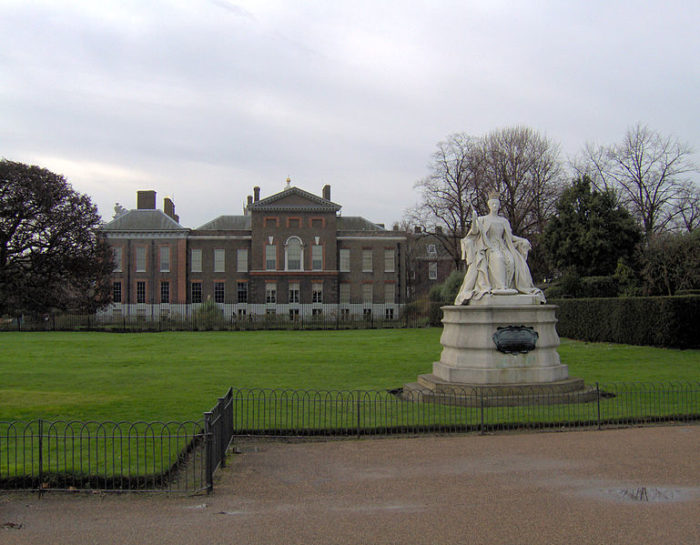 Kensington Palace with Queen Victoria’s Statue in the Foreground
Kensington Palace with Queen Victoria’s Statue in the Foreground
This young couple are taking up residence at Kensington Palace; one of London’s most enchanting palaces and a place where several Monarchs and families of Monarchs have made their home. In the recent past it has been the London home of the late Princess Margaret, Countess of Snowden, the Late Diana, Princess of Wales and the late Dowager Duchess of Gloucester, the Princess Alice.
So Kensington Palace and the borough of Kensington has family members in its very enclaves and it has been like this since the time of the Glorious Revolution of 1688 which deposed James II and brought over from the Netherlands his daughter and son-in-law, King William III and his wife, Queen Mary II as joint rulers.
‘While the town is damp and darkness lies,
They breathe in sunshine and see azure blue skies’…..
So the poets said when talking about the Village of Kensington. It is hard to believe today that in this busy and vibrant part of West London, Kensington was a village surrounded by farms, nurseries and gardens. Within 15 years of William and Mary making it their home, the village was three times larger than Chelsea.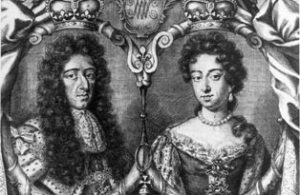
Print of King William III and Queen Mary II. Copyright: Historic Royal Palaces
It is 1689 and suffering from asthma, William III decides to purchase a house in the country, away from the noise, dirt and the London mob. Whitehall Palace was neither a convenient or healthy place to live in and Nottingham House had not only a large garden to enjoy lazy afternoons but space for improvement and opportunities to create something special. The first house was built from 1614-1620, when George Coppin designed a modest manor house on the site. It was then purchased at a later date by Heneage Finch, the first Earl of Nottingham, and the manor house was named Nottingham House. It was later sold by Daniel Finch, the second Earl, who incidentally was Secretary of State from 1689 to 1693 and again from 1702 to 1704, for the tidy sum of £20,000 to William and Mary.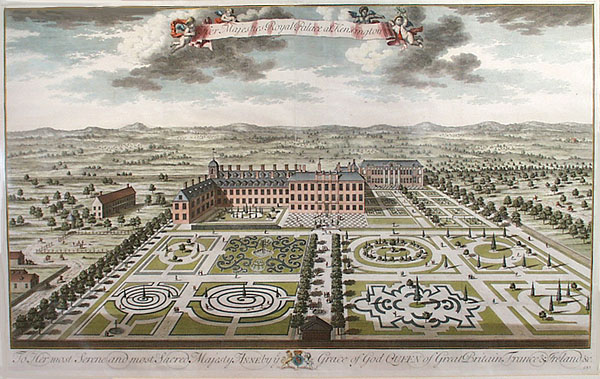 Historic Print, Kensington Palace and its Gardens, circa 1720s
Historic Print, Kensington Palace and its Gardens, circa 1720s
That young couple were spurred into building with the surveyor of the King’s Work’s by their side, Sir Christopher Wren. Wren kept the shell of the old house but added charming three story pavilions to the four corners, a new entrance on the west front, a narrow block of rooms to the south, new kitchens and a clock tower surmounting an archway to the west of the great court. These beautiful rooms can be seen and enjoyed today. They have mellowed oak and walnut panelling, beautiful furniture and paintings which belong to the Royal Collection and the remains of the blue and white porcelain in the ‘China taste’ that Queen Mary II loved. It was she who brought the ceramics over from the Netherlands and so started the craze ‘China Mania.’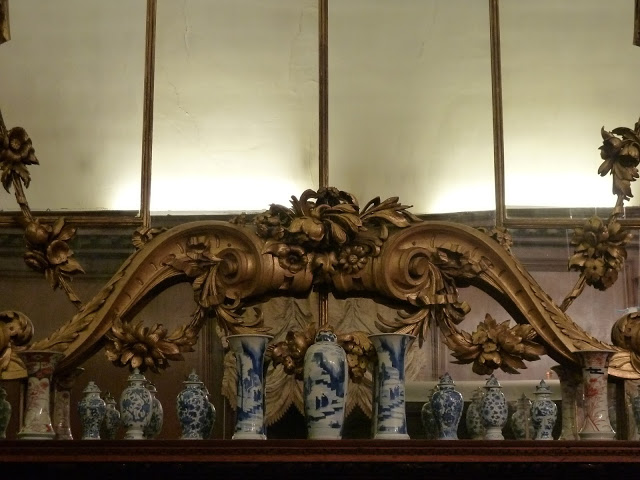 Blue & White Ceramics at Kensington Palace
Blue & White Ceramics at Kensington Palace
For over seventy years, from the time of William and Mary onwards, Kensington Palace played host to Monarchs who each left their personality on the place but the official seat of the Court was, and still remains, St James’s Palace.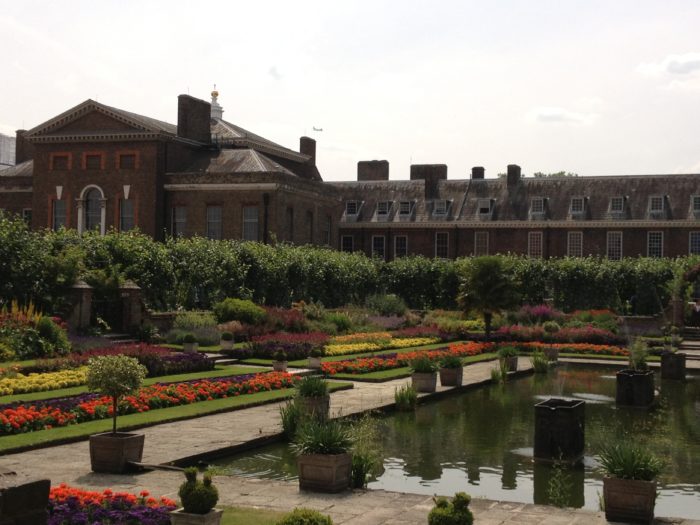 Kensington Palace and the Sunken Gardens. photo by Tara Draper-Stumm
Kensington Palace and the Sunken Gardens. photo by Tara Draper-Stumm
In 1694 Queen Mary II died of smallpox at Kensington. Her husband lived there alone until 1702. Whilst riding at Hampton Court he suffered a fall from his horse, dying at Kensington not long after. The new Monarch, Queen Anne made Kensington her home until she died in 1714. Queen Anne also made changes. She instructed Nicholas Hawksmoor to build the Orangery in 1704. Henry Wise, the Royal Gardener, created the 30 acre baroque formal parterre as well as the gardens surrounding the palace. The new Queen also created a Deer paddock. View of the Gardens and Orangery, Kensington Palace. photo by Tara Draper-Stumm
View of the Gardens and Orangery, Kensington Palace. photo by Tara Draper-Stumm
It was Henry Wise who was enticed away from Queen Anne by the Duke of Buckingham who had recently purchased Arlington House at the foot of the newly created Mall and renamed his newly built house Buckingham House. Wise created formal gardens in the French vogue but these were swept away by Capability ‘Lancelot’ Brown in the 1760’s when Buckingham House was purchased by George III for his young bride, Charlotte of Mecklenburg Strelitz. Now these famous gardens are opened to the public when Buckingham Palace is open during the summer season and visitors can enjoy summer garden highlight tours as well as visiting the state rooms of the palace.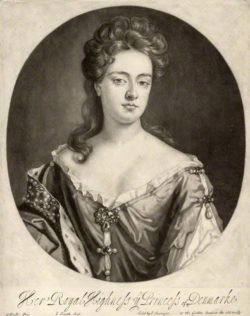
Historic Print of Queen Anne when Princess of Denmark
Returning to Kensington Palace though, Queen Anne not only created the formal gardens but also completed the set of state rooms that had been designed for William and Mary. Wren was retained and he completed a state staircase with shallow steps together with a set of rooms used by Queen Anne.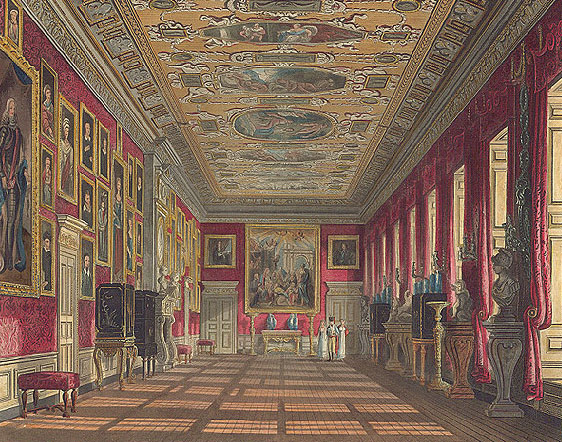 The Picture Gallery at Kensington Palace
The Picture Gallery at Kensington Palace
When Anne died in 1714 there was panic amongst the aristocracy as the Queen had died without issue. None of her children had reached adulthood. It took an Act of Parliament, known as the 1701 Act of Settlement to invite her distant cousin and successor, George, Elector of Hanover to become King George I.
The beginning of the Hanoverian dynasty and a new chapter for Kensington was opening its pages.
George I loved Kensington Palace and he lavished great sums of money on building and improving it. He employed Colen Campbell as chief architect and in 1722, replacing Sir James Thornhill, William Kent was commissioned to redecorate a staircase and paint a few ceilings.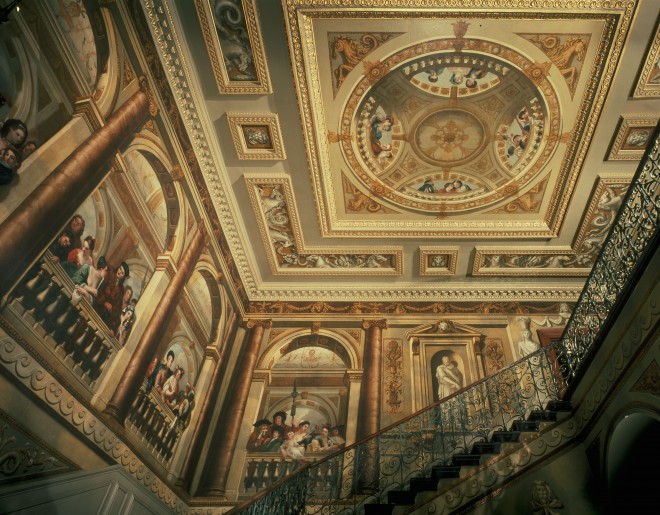 The Painted Staircase, Kensington Palace
The Painted Staircase, Kensington Palace
If you visit the palace you can meet members of the Court of George I as the king commissioned portraits of them in a mural which decorates the wall around a grand staircase. You may meet the Yeoman of the Guard, a Polish dwarf, one or two Turkish Grooms of the Bedchamber and a wild boy who was found in the woods near Hanover and brought to England to entertain the King!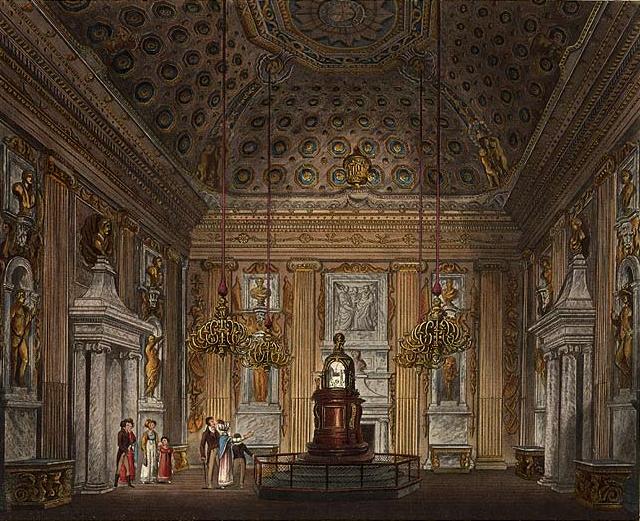 The Cupola Room, Kensington Palace
The Cupola Room, Kensington Palace
From 1722 to 1725 Kent returned to design the Cupola Room which has feigned coffering in its coved ceiling. This beautiful room was used for the Christening of the baby Princess Alexandra Victoria, who was the only daughter of the Duke and Duchess of Kent. Victoria was born in May 1819 and lived at Kensington Palace with her Mother, the Dowager Duchess until she became Queen at 18 in 1837. Her rooms are open to the public and many items from Victoria’s childhood are on display.
The last Monarch to use Kensington Palace and call it home was King George II. He employed Charles Bridgeman to create a new garden for his consort, Queen Caroline. If you care to wander through the leafy glades of Kensington gardens today you can still appreciate the gardens that were created in the first quarter of the 18th century. It was Bridgeman who designed the serpentine lake, the round pond and the Broad Walk.
By the time King George III came to the throne, Kensington Palace was given to other members of the family and that tradition is still enforce today.
The palace was not only associated with Queen Victoria. King George IV’s wife Caroline of Brunswick had apartments there after her divorce from the king in 1820. She was often grudgingly visited by her daughter, Charlotte, Princess of Wales. Sadly that lady died tragically in childbirth in 1816 after her marriage to Leopold; so propelling the line of succession into jeopardy once more. It took two arranged marriages for two of George III sons to beget an heir to the throne. Edward, Duke of Kent won the race as his daughter was Victoria, Whilst William and Adelaide’s children did not live to adulthood, so Victoria inherited the throne in 1837 when her uncle, William died.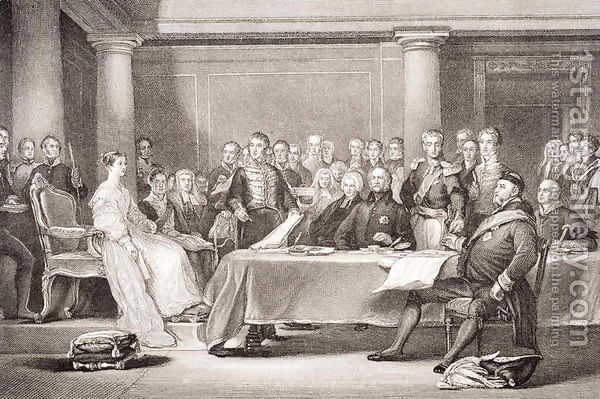 Historic Print of Queen Victoria’s First Council Meeting at Kensington Palace, 1837
Historic Print of Queen Victoria’s First Council Meeting at Kensington Palace, 1837
It was Queen Victoria who opened the palace to the public on her birthday, 24th May 1899. One of her daughter’s, Princess Louise, was a renowned sculptor and had a studio there. If you take a stroll in the gardens you will see a fine statue of Victoria created by Princess Louise.
Her Majesty Queen Elizabeth II’s Grandmother Queen Mary was also born at Kensington in 1867. She was known as Princess May of Teck, the only daughter of Princess Mary Adelaide of Cambridge and her husband, Prince Francis of Teck. She married, in 1893, Prince George of Wales, the second son of the Prince and Princess of Wales, Edward and Alexandra, who later became Edward VII and Queen Alexandra. In 1910 Princess May became Queen Consort when her husband became King George V.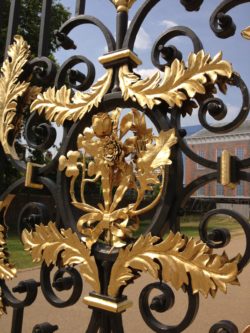
The Elegant Gilded Iron Gates at Kensington Palace Today. photo by Tara Draper-Stumm
Today the palace is operated by Historic Royal Palaces and the contents are owned by the Royal Collection and is open to the public, but it is still lovely to know that it is still the home of other members of the Royal Family, including the Duke and Duchess of Kent who reside at Wren House, Prince and Princess Michael of Kent, the Duke and Duchess of Gloucester, Prince Harry of Wales and when their apartment is completed and refurbished, the Duke and Duchess of Cambridge.
You have read a brief synopsis of the history of this enchanting place. In my next installment I will discuss the palace collections including a selection of very interesting clocks, some of which are musical.
by Stephen Wild
Further Reading:
JH Plumb and H Wheldon, Royal Heritage: The Story of Britain’s Royal Builders and Collectors (London, 1977)
Christopher Simon Sykes, Private Palaces: Life in the Great London Houses (London, 1985)
David Soudon, The Royal Palaces of London (London, 2008)
To top all of these amazing events there is further excitement and anticipation a foot as in the next few days Britain, and indeed, the world, are looking forward to hearing good news from the two young, vibrant and glamorous of couples, TRH The Duke and Duchess of Cambridge as they are expecting their first arrival of a new baby and a future heir to the British Throne.
 Kensington Palace with Queen Victoria’s Statue in the Foreground
Kensington Palace with Queen Victoria’s Statue in the ForegroundThis young couple are taking up residence at Kensington Palace; one of London’s most enchanting palaces and a place where several Monarchs and families of Monarchs have made their home. In the recent past it has been the London home of the late Princess Margaret, Countess of Snowden, the Late Diana, Princess of Wales and the late Dowager Duchess of Gloucester, the Princess Alice.
So Kensington Palace and the borough of Kensington has family members in its very enclaves and it has been like this since the time of the Glorious Revolution of 1688 which deposed James II and brought over from the Netherlands his daughter and son-in-law, King William III and his wife, Queen Mary II as joint rulers.
‘While the town is damp and darkness lies,
They breathe in sunshine and see azure blue skies’…..
So the poets said when talking about the Village of Kensington. It is hard to believe today that in this busy and vibrant part of West London, Kensington was a village surrounded by farms, nurseries and gardens. Within 15 years of William and Mary making it their home, the village was three times larger than Chelsea.

Print of King William III and Queen Mary II. Copyright: Historic Royal Palaces
It is 1689 and suffering from asthma, William III decides to purchase a house in the country, away from the noise, dirt and the London mob. Whitehall Palace was neither a convenient or healthy place to live in and Nottingham House had not only a large garden to enjoy lazy afternoons but space for improvement and opportunities to create something special. The first house was built from 1614-1620, when George Coppin designed a modest manor house on the site. It was then purchased at a later date by Heneage Finch, the first Earl of Nottingham, and the manor house was named Nottingham House. It was later sold by Daniel Finch, the second Earl, who incidentally was Secretary of State from 1689 to 1693 and again from 1702 to 1704, for the tidy sum of £20,000 to William and Mary.
 Historic Print, Kensington Palace and its Gardens, circa 1720s
Historic Print, Kensington Palace and its Gardens, circa 1720sThat young couple were spurred into building with the surveyor of the King’s Work’s by their side, Sir Christopher Wren. Wren kept the shell of the old house but added charming three story pavilions to the four corners, a new entrance on the west front, a narrow block of rooms to the south, new kitchens and a clock tower surmounting an archway to the west of the great court. These beautiful rooms can be seen and enjoyed today. They have mellowed oak and walnut panelling, beautiful furniture and paintings which belong to the Royal Collection and the remains of the blue and white porcelain in the ‘China taste’ that Queen Mary II loved. It was she who brought the ceramics over from the Netherlands and so started the craze ‘China Mania.’
 Blue & White Ceramics at Kensington Palace
Blue & White Ceramics at Kensington PalaceFor over seventy years, from the time of William and Mary onwards, Kensington Palace played host to Monarchs who each left their personality on the place but the official seat of the Court was, and still remains, St James’s Palace.
 Kensington Palace and the Sunken Gardens. photo by Tara Draper-Stumm
Kensington Palace and the Sunken Gardens. photo by Tara Draper-StummIn 1694 Queen Mary II died of smallpox at Kensington. Her husband lived there alone until 1702. Whilst riding at Hampton Court he suffered a fall from his horse, dying at Kensington not long after. The new Monarch, Queen Anne made Kensington her home until she died in 1714. Queen Anne also made changes. She instructed Nicholas Hawksmoor to build the Orangery in 1704. Henry Wise, the Royal Gardener, created the 30 acre baroque formal parterre as well as the gardens surrounding the palace. The new Queen also created a Deer paddock.
 View of the Gardens and Orangery, Kensington Palace. photo by Tara Draper-Stumm
View of the Gardens and Orangery, Kensington Palace. photo by Tara Draper-StummIt was Henry Wise who was enticed away from Queen Anne by the Duke of Buckingham who had recently purchased Arlington House at the foot of the newly created Mall and renamed his newly built house Buckingham House. Wise created formal gardens in the French vogue but these were swept away by Capability ‘Lancelot’ Brown in the 1760’s when Buckingham House was purchased by George III for his young bride, Charlotte of Mecklenburg Strelitz. Now these famous gardens are opened to the public when Buckingham Palace is open during the summer season and visitors can enjoy summer garden highlight tours as well as visiting the state rooms of the palace.

Historic Print of Queen Anne when Princess of Denmark
Returning to Kensington Palace though, Queen Anne not only created the formal gardens but also completed the set of state rooms that had been designed for William and Mary. Wren was retained and he completed a state staircase with shallow steps together with a set of rooms used by Queen Anne.
 The Picture Gallery at Kensington Palace
The Picture Gallery at Kensington PalaceWhen Anne died in 1714 there was panic amongst the aristocracy as the Queen had died without issue. None of her children had reached adulthood. It took an Act of Parliament, known as the 1701 Act of Settlement to invite her distant cousin and successor, George, Elector of Hanover to become King George I.
The beginning of the Hanoverian dynasty and a new chapter for Kensington was opening its pages.
George I loved Kensington Palace and he lavished great sums of money on building and improving it. He employed Colen Campbell as chief architect and in 1722, replacing Sir James Thornhill, William Kent was commissioned to redecorate a staircase and paint a few ceilings.
 The Painted Staircase, Kensington Palace
The Painted Staircase, Kensington PalaceIf you visit the palace you can meet members of the Court of George I as the king commissioned portraits of them in a mural which decorates the wall around a grand staircase. You may meet the Yeoman of the Guard, a Polish dwarf, one or two Turkish Grooms of the Bedchamber and a wild boy who was found in the woods near Hanover and brought to England to entertain the King!
 The Cupola Room, Kensington Palace
The Cupola Room, Kensington PalaceFrom 1722 to 1725 Kent returned to design the Cupola Room which has feigned coffering in its coved ceiling. This beautiful room was used for the Christening of the baby Princess Alexandra Victoria, who was the only daughter of the Duke and Duchess of Kent. Victoria was born in May 1819 and lived at Kensington Palace with her Mother, the Dowager Duchess until she became Queen at 18 in 1837. Her rooms are open to the public and many items from Victoria’s childhood are on display.
The last Monarch to use Kensington Palace and call it home was King George II. He employed Charles Bridgeman to create a new garden for his consort, Queen Caroline. If you care to wander through the leafy glades of Kensington gardens today you can still appreciate the gardens that were created in the first quarter of the 18th century. It was Bridgeman who designed the serpentine lake, the round pond and the Broad Walk.
By the time King George III came to the throne, Kensington Palace was given to other members of the family and that tradition is still enforce today.
The palace was not only associated with Queen Victoria. King George IV’s wife Caroline of Brunswick had apartments there after her divorce from the king in 1820. She was often grudgingly visited by her daughter, Charlotte, Princess of Wales. Sadly that lady died tragically in childbirth in 1816 after her marriage to Leopold; so propelling the line of succession into jeopardy once more. It took two arranged marriages for two of George III sons to beget an heir to the throne. Edward, Duke of Kent won the race as his daughter was Victoria, Whilst William and Adelaide’s children did not live to adulthood, so Victoria inherited the throne in 1837 when her uncle, William died.
 Historic Print of Queen Victoria’s First Council Meeting at Kensington Palace, 1837
Historic Print of Queen Victoria’s First Council Meeting at Kensington Palace, 1837It was Queen Victoria who opened the palace to the public on her birthday, 24th May 1899. One of her daughter’s, Princess Louise, was a renowned sculptor and had a studio there. If you take a stroll in the gardens you will see a fine statue of Victoria created by Princess Louise.
Her Majesty Queen Elizabeth II’s Grandmother Queen Mary was also born at Kensington in 1867. She was known as Princess May of Teck, the only daughter of Princess Mary Adelaide of Cambridge and her husband, Prince Francis of Teck. She married, in 1893, Prince George of Wales, the second son of the Prince and Princess of Wales, Edward and Alexandra, who later became Edward VII and Queen Alexandra. In 1910 Princess May became Queen Consort when her husband became King George V.

The Elegant Gilded Iron Gates at Kensington Palace Today. photo by Tara Draper-Stumm
Today the palace is operated by Historic Royal Palaces and the contents are owned by the Royal Collection and is open to the public, but it is still lovely to know that it is still the home of other members of the Royal Family, including the Duke and Duchess of Kent who reside at Wren House, Prince and Princess Michael of Kent, the Duke and Duchess of Gloucester, Prince Harry of Wales and when their apartment is completed and refurbished, the Duke and Duchess of Cambridge.
You have read a brief synopsis of the history of this enchanting place. In my next installment I will discuss the palace collections including a selection of very interesting clocks, some of which are musical.
by Stephen Wild
Further Reading:
JH Plumb and H Wheldon, Royal Heritage: The Story of Britain’s Royal Builders and Collectors (London, 1977)
Christopher Simon Sykes, Private Palaces: Life in the Great London Houses (London, 1985)
David Soudon, The Royal Palaces of London (London, 2008)

